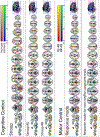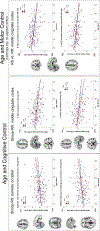Effects of age, sex, and puberty on neural efficiency of cognitive and motor control in adolescents
- PMID: 30903550
- PMCID: PMC6756998
- DOI: 10.1007/s11682-019-00075-x
Effects of age, sex, and puberty on neural efficiency of cognitive and motor control in adolescents
Abstract
Critical changes in adolescence involve brain cognitive maturation of inhibitory control processes that are essential for a myriad of adult functions. Cognitive control advances into adulthood as there is more flexible integration of component processes, including inhibitory control of conflicting information, overwriting inappropriate response tendencies, and amplifying relevant responses for accurate execution. Using a modified Stroop task with fMRI, we investigated the effects of age, sex, and puberty on brain functional correlates of cognitive and motor control in 87 boys and 91 girls across the adolescent age range. Results revealed dissociable brain systems for cognitive and motor control processes, whereby adolescents flexibly adapted neural responses to control demands. Specifically, when response repetitions facilitated planning-based action selection, frontoparietal-insular regions associated with cognitive control operations were less activated, whereas cortical-pallidal-cerebellar motor regions associated with motor skill acquisition, were more activated. Attenuated middle cingulate cortex activation occurred with older adolescent age for both motor control and cognitive control with automaticity from repetition learning. Sexual dimorphism for control operations occurred in extrastriate cortices involved in visuo-attentional selection: While boys enhanced extrastriate selection processes for motor control, girls activated these regions more for cognitive control. These sex differences were attenuated with more advanced pubertal stage. Together, our findings show that brain cognitive and motor control processes are segregated, demand-specific, more efficient in older adolescents, and differ between sexes relative to pubertal development. Our findings advance our understanding of how distributed brain activity and the neurodevelopment of automaticity enhances cognitive and motor control ability in adolescence.
Keywords: Age and gender; Automaticity of behavior; Executive control; Functional MRI; Puberty.
Conflict of interest statement
DISCLOSURES
None of the authors have conflicts of interest with the reported data or their interpretation.
Figures






References
-
- Adleman NE, Menon V, Blasey CM, White CD, Warsofsky IS, Glover GH, Reiss AL (2002) A developmental fMRI study of the Stroop color-word task. Neuroimage. 16(1): .61–75. - PubMed
-
- Akshoomoff N, Newman E, Thompson WK, McCabe C, Bloss CS, Chang L, Amaral DG, Casey BJ, Ernst TM, Frazier JA, Gruen JR, Kaufmann WE, Kenet T, Kennedy DN, Libiger O, Mostofsky S, Murray SS, Sowell ER, Schork N, Dale AM, Jernigan TL (2014) The NIH toolbox cognition battery: Results from a large normative developmental sample (ping). Neuropsychology. 28:1–10. - PMC - PubMed
MeSH terms
Grants and funding
- U24 AA021695/AA/NIAAA NIH HHS/United States
- U01 AA021697/AA/NIAAA NIH HHS/United States
- R37 AA010723/AA/NIAAA NIH HHS/United States
- AA021692/National Institute on Alcohol Abuse and Alcoholism
- AA021697/National Institute on Alcohol Abuse and Alcoholism
- U01 AA021695/AA/NIAAA NIH HHS/United States
- U01 AA021692/AA/NIAAA NIH HHS/United States
- R01 AA010723/AA/NIAAA NIH HHS/United States
- U01 AA021696/AA/NIAAA NIH HHS/United States
- AA021695/National Institute on Alcohol Abuse and Alcoholism
- U24 AA021697/AA/NIAAA NIH HHS/United States
- AA010723/National Institute on Alcohol Abuse and Alcoholism
- AA021696/National Institute on Alcohol Abuse and Alcoholism (US)
LinkOut - more resources
Full Text Sources
Medical

